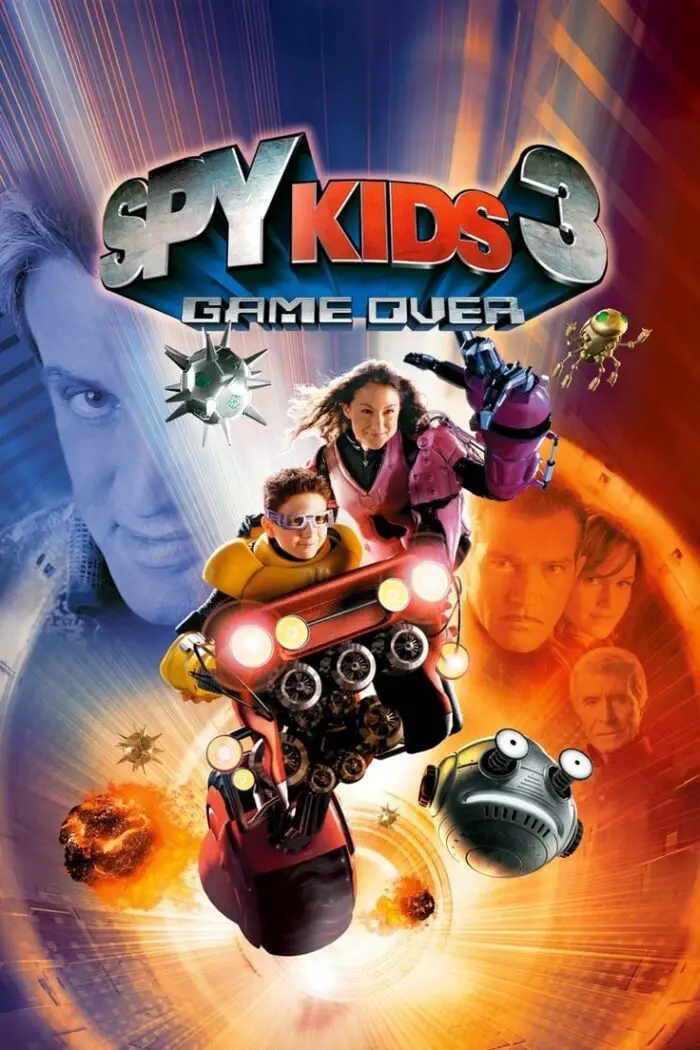Since the Victorian era, 3D pictures have always been falling in and out of fashion. First, there were stereoscopes, then there were red-and-blue-lensed 3D glasses and View-Masters, and now there’s polarized, sunglass-like 3D shades that at least look a little cooler and less goofy than the others. In every wave of 3D entertainment, there’s always a few gems that hit the right mark for coolness and goofiness. And it would be a crime not to give props to Spy Kids 3-D: Game Over (SK3DGO) for this endearing wackiness.

When the movie came out in 2003, it was riding off the success of the Spy Kids franchise’s previous action-adventure family comedies—the “James Bond meets Willy Wonka” Spy Kids (2001) and the “James Bond meets Mysterious Island” Spy Kids 2: The Island of Lost Dreams (2002). Two siblings, Carmen (Alexa Vega) and Juni Cortez (Daryl Sabara), get tied up in their parents’ espionage acts and eventually become professional kid spies themselves.
By the time SK3DGO came along, Juni was already a retired preteen who wanted nothing more to do with missions. But when Carmen goes missing inside “Game Over,” a video game designed by the antagonist Toymaker (Sylvester Stallone), Juni puts on a pair of 3D glasses and gears up to rescue his sister.
As Juni ventures into the game, the stakes heighten as he finds out he only has 12 hours and limited lives to lose in order to find Carmen and shut down the game. The catch is, if Juni fails, it’s more than just “game over.” Elements from the game may escape into the real world, leading to disastrous consequences.
The 20th anniversary of SK3DGO couldn’t have arrived at a better time. Video games are having another moment to shine in theaters and on streaming services with successful adaptations like The Super Mario Bros. Movie, Dungeons & Dragons: Honor Among Thieves and HBO’s The Last of Us. While SK3DGO wasn’t based on an actual video game (though one was developed for PC and GameBoy Advance), it certainly feels like an adaptation of what games could be and are becoming with virtual reality technology.
It’s no Tron Legacy or Ready Player One, but writer-director-editor-composer Robert Rodriguez put together an epic home movie on steroids that is still a joy to watch even 20 years later. (Now granted, I was born in 2000 and don’t actually remember the day SK3DGO was released in theaters. But I do remember watching it over and over again as a kid when it came out on DVD. The complimentary red-blue glasses stuffed inside the plastic case let me look like the “Game Over” players and take in all the 3D goodness.)
Along Juni’s trek, he’s joined by both friends and foes. However, he can’t be too sure which is which. After all, when roaming a digital world, anyone can pose as whoever they’d like to be, whether that be an accurate or deceptive depiction of their true self.

SK3DGO progresses nicely with each new character and conflict plot point revealing itself as another level within the game. From jumping with toads on pogo sticks to fighting Pacific Rim-style robots in outer space to surfing an ocean of lava, Juni and his teammates are having quite the adventure and taking the audience along for the ride.
Simply put, SK3DGO’s creativity is amazing. On top of its 1,400 special effects, at least 90% of the film was shot in front of a green screen by two cameras capturing the left and right eye perspectives to pull off the 3D illusion. Fortunately, it’s the most admirable part of the movie. Unfortunately, it’s the most inconvenient part of the movie.
Alex Toader, the main concept artist and Rodriguez’s first hire at Troublemaker Studios (now Double R Productions), said, “If you’re using the blue-red glasses, the colors are very muted. You get purples, greens, and that’s about it. Everything else in between is a little muddy.”
Had SK3DGO been released a few years later, when most theaters were able to screen polarized 3D films, it would have been incredible. And with 4DX immersive technology coming along in both popularity and quality these days, SK3DGO would have been gobsmacking had it been released today. But it’s all in the movie’s charm that it came out when and how it did. (After losing my original copy, I’ve since bought another DVD and still rewatch it now and then.)
Toader designed many of SK3DGO’s most iconic settings and elements, including Juni and Carmen’s in-game suits and the vehicles driven during the wild mega-racing level.
“Robert didn’t want just cars. He wanted something out there—motorcycles with big wheels, tiny wheels or just one wheel. Something that looked like a scorpion or an ice cream cone or an old-fashioned, retro-looking rocket you’d see in sci-fi movies from the 30s,” Toader said.
With the help of colleagues Rodney Brunet, Chris Olivia, and technical director Cid Newman, Toader and the team worked on pre-visualizations, concepts, animation and compositing to bring Rodriguez’s vision to life.
Toader added, “Robert wears so many hats, so he expects everybody that works for him to do the same, have knowledge, be productive and contribute to the process from pre-production to production to post-production—not be a one-trick pony.”
The Spy Kids franchise’s behind-the-scenes collaboration carries over to the on-screen theme of family in a genuinely wholesome way. There’s only a teensy bit of cringiness when SK3DGO ends with a big cheery “To Family!” hoorah, but everything feels just right and complete in the closing line: “It’s not whether you win or lose. It’s how you play the game.”




